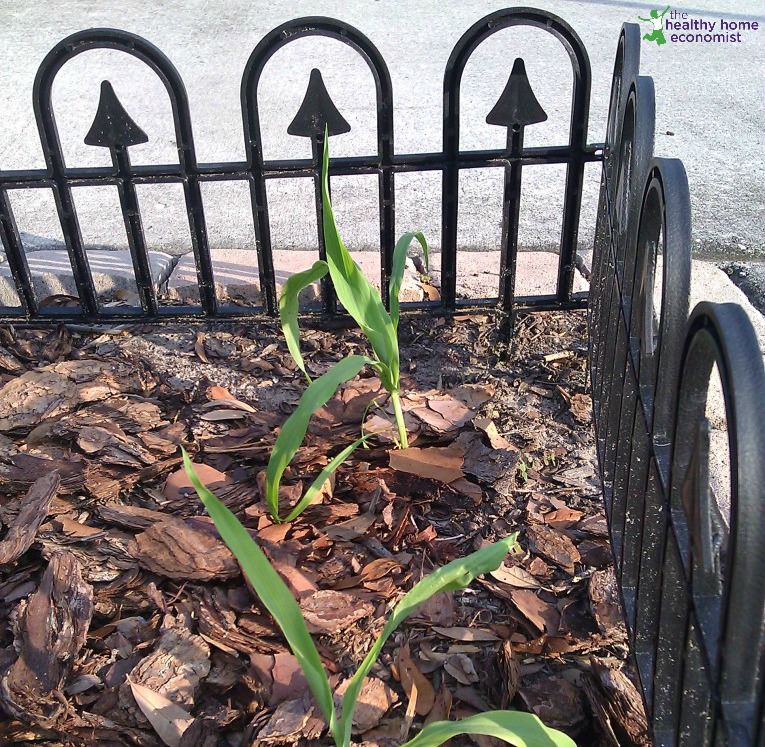 When I received my organic seed packets this Spring, I immediately picked out the package of broom corn to plant as I knew that corn does well in very hot conditions. Since I was planting in late spring in Central FL, I figured that hardiness would be very important if the plants had any chance at all of survival through the very long, hot summer.
When I received my organic seed packets this Spring, I immediately picked out the package of broom corn to plant as I knew that corn does well in very hot conditions. Since I was planting in late spring in Central FL, I figured that hardiness would be very important if the plants had any chance at all of survival through the very long, hot summer.
I posted a picture of a corn seedling two weeks ago, and I am happy to report that the one seedling in that picture is still growing strong! One other corn seedling survived transplanting into the garden, but unfortunately, only those two made it through the extreme heat long enough to take root.
My kids were getting excited about the corn that was growing as we were anticipating throwing the cobs into the fire pit in the backyard and roasting them. Corn on the cob roasted in a fire is absolutely delicious if you haven’t tried it before!
I started to do a little research on broom corn, however, and discovered that broom corn is not a variety of corn on the cob. As it turns out, broom corn has more decorative and industrial uses than for eating.
Broom Corn is Not a Corn At All
Even more surprising, broom corn is not a corn at all but a plant related to the sorghums used for grains and syrup. You certainly don’t pop it like popcorn.
The head of broom corn is very fibrous and has been used for hundreds of years to make, you guessed it, BROOMS! It takes about 60 heads to make one broom, so given that I have only two seedlings growing and not enough room in my garden to grow 58 more, it seems making a broom with the kids is out of the question!
The vibrant color variety of the seeds in the broom head make broom corn ideal for inclusion with wreaths and floral/autumnal arrangements.
My big question is, can you eat broom corn? I was thinking I could take the seeds and dry them and pop them into popcorn but perhaps this wouldn’t work as broom corn is not really even corn.
Broom corn is used in bird seed, so perhaps I can use it in my bird feeder.
If any of you have any additional ideas, please share!
Sarah, The Healthy Home Economist








I was just looking for broom corn recipes online, and found on WebMD that broom corn is sometimes eaten to soothe the digestive system, though there is insufficient data to substantiate this claim. My neighbor threw her broom corn into my last garden cleanup fire this fall, and it made little, Barbie-size (or Elf on the Shelf-sized) pieces of popcorn. After seeing that, I saved the rest of the seeds to grow next summer. I just dry-popped a bit more of it, to make a bowl of popcorn for our Elf on the Shelf to enjoy with a little movie. After I grow some next year, I will try to cook some in the way you’d cook millet, b’cos it smelled nice and nutty as I popped it.
Well just today I had a bowl of soup made in the rice cooker with broomcorn and split lentils. Simple and yummi!
Yes broom corn is edible. I grind the seeds up in a grain mill (OK, I actually use a blender) and add the meal to breads. Although I’ve not experienced a problem, I have read that broom corn can be an “accumulator plant” and take up heavy metals from the soil–can’t remember which ones. Provided your soil test comes out good, the broom corn should be safe to eat. Conversely, if your soil is contaminated, the broom corn can help detoxify the soil. Just don’t eat it. Use the ornamental seed heads in craft projects. It’s a win-win situation!
You wouldn’t have been able to grow real corn with so few plants anyway. They have a hard time pollinating without planting a ton. You could end up with any variety of problems from tiny ears, to no ears, to having a bunch of gaps where kernels were supposed to be.
I wonder if it would be bitter? Grain sorghum grown for flour and such is specifically bred to reduce bitterness. Grain sorghum is normally white and has a smoother flavor than red. If it is not bitter not, you can also use it to make couscous. We grow both grain sorghum and the variety used to make sorghum molasses. We use the grain variety in our chicken feed, for and occasionally flour, couscous, and popping. We also occasionally make sorghum beer.
Thanks for the link, but oh wow, now I am really confused! The little broomcorn seeds look just like small pieces of corn. They are not round like millet. It will be interesting to see what happens as these stalks get bigger. If they are millet, I will soak them and eat them for breakfast porridge as I do love an occasional bowl of soaked millet.
Hey Sarah, I did a little quick searching, and it looks like broom corn is actually millet! If that’s right, then it certainly is edible (and only two stalks probably won’t produce enough to be a thyroid issue). Here’s the page that I found: http://www.allproducts.com/manufacture98/hebeifoods/product1.html